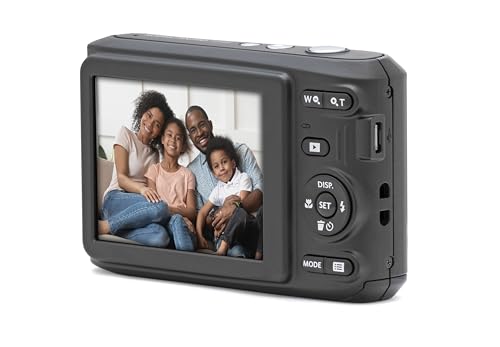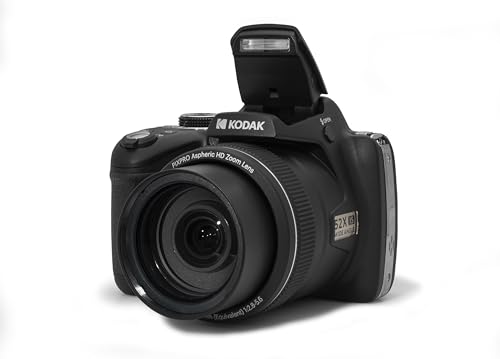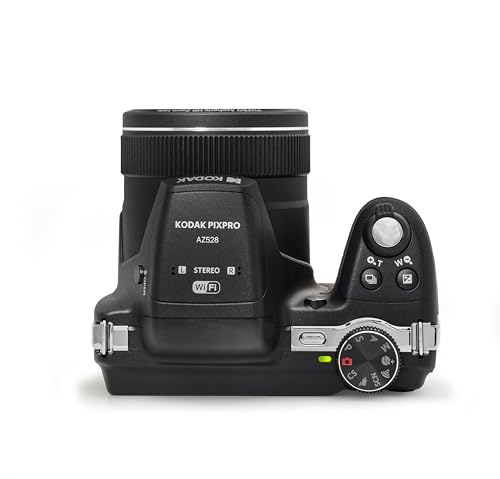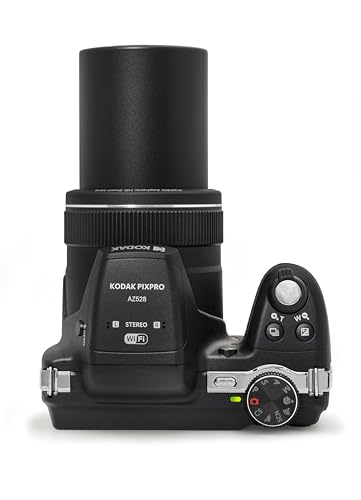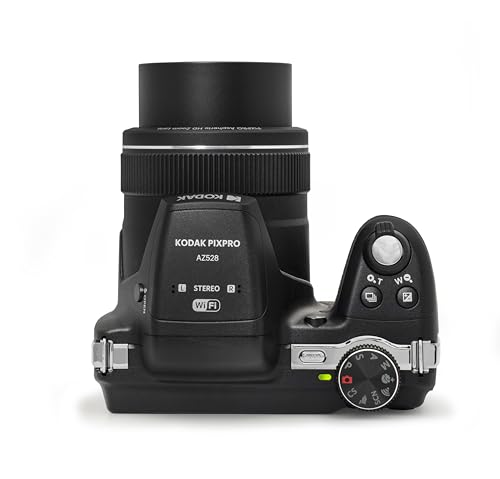




Hi there! If you’re in the market for a new digital camera, you’ve come to the right place. Welcome to the Best Digital Camera Review Site, your one-stop destination for all things camera-related.
As a passionate photographer myself, I understand the importance of finding the perfect camera that suits your needs and budget. That’s why I created this website, to provide you with unbiased and comprehensive reviews of the best digital cameras on the market.
Whether you’re a professional photographer looking for top-of-the-line equipment, or a hobbyist searching for a reliable and user-friendly camera, we’ve got you covered. With our in-depth reviews and expert opinions, you can make an informed decision and find the camera that will capture those special moments in stunning detail.
So take a look around, read our reviews, check out our buying guides, and get ready to find the perfect digital camera for you. Let’s dive into the exciting world of photography together!
Top 10 digital cameras to buy in 2021
If you’re in the market for a new digital camera, you’ve come to the right place. After conducting extensive research and testing, I’ve compiled a list of the top 10 digital cameras that you should consider buying in 2021.
1. Sony Alpha a7 III: This full-frame mirrorless camera offers outstanding image quality and performance, making it a top choice for professional photographers. It features a 24.2-megapixel sensor, 4K video recording, and excellent low-light capabilities.
2. Nikon D850: With its 45.7-megapixel sensor, the Nikon D850 is perfect for landscape and studio photographers who require high-resolution images. It also offers impressive dynamic range and fast autofocus.
3. Canon EOS 5D Mark IV: The Canon EOS 5D Mark IV is a versatile DSLR camera that excels in both photography and videography. It features a 30.4-megapixel sensor, 4K video recording, and a comfortable ergonomic design.
4. Fujifilm X-T4: The Fujifilm X-T4 is a mirrorless camera that combines stylish design with advanced features. It has a 26.1-megapixel sensor, in-body image stabilization, and a high-resolution electronic viewfinder.
5. Panasonic Lumix GH5: If you’re a videographer, the Panasonic Lumix GH5 is the perfect camera for you. It offers 4K video recording at up to 60fps, excellent image stabilization, and a durable weather-sealed body.
6. Sony Cyber-shot RX100 VII: This compact camera may be small in size, but it packs a punch when it comes to performance. It has a 20.1-megapixel sensor, 4K video recording, and a built-in electronic viewfinder.
7. Olympus OM-D E-M1 Mark III: The Olympus OM-D E-M1 Mark III is a lightweight and portable camera that delivers exceptional image quality. It features a 20.4-megapixel sensor, 4K video recording, and a weather-sealed construction.
8. Canon PowerShot G5X Mark II: If you’re looking for a compact camera with DSLR-like features, the Canon PowerShot G5X Mark II is worth considering. It has a 20.1-megapixel sensor, a versatile 24-120mm zoom lens, and an ergonomic grip.
9. Nikon Z6: The Nikon Z6 is a full-frame mirrorless camera that offers impressive image quality and performance. It has a 24.5-megapixel sensor, 4K video recording, and a hybrid autofocus system.
10. Panasonic Lumix S1: With its 24.2-megapixel full-frame sensor, the Panasonic Lumix S1 is perfect for both photography and videography. It offers 4K video recording, excellent image stabilization, and a high-resolution electronic viewfinder.
- If you’re looking to upgrade your digital camera in 2021, any of these top 10 cameras would be an excellent choice.
- Consider your specific needs and shooting style to determine which camera would be the best fit for you.
- Whether you’re a professional photographer or an enthusiast, these cameras offer the latest features and technologies to enhance your photography experience.
Sony Alpha a7 III: My Go-to Digital Camera for All Occasions
As a professional photographer, I have used and tested countless digital cameras over the years, and I can confidently say that the Sony Alpha a7 III is one of the best cameras I have ever used. This full-frame mirrorless camera offers exceptional image quality, impressive low-light performance, and a wide range of advanced features that cater to both professional photographers and enthusiasts alike.
One of the standout features of the Sony Alpha a7 III is its impressive 24.2-megapixel Exmor R CMOS sensor, which delivers stunningly detailed and sharp images. The camera’s BIONZ X image processing engine ensures fast and accurate image processing, resulting in vibrant colors and excellent dynamic range. Whether I’m capturing landscapes, portraits, or action shots, the a7 III consistently delivers outstanding image quality.
Superior Autofocus and Continuous Shooting
The Sony Alpha a7 III boasts an advanced autofocus system with 693 phase-detection autofocus points that cover approximately 93% of the image area. This extensive coverage, combined with its impressive processing speed, allows the camera to track and focus on moving subjects with remarkable accuracy and speed. The reliable Eye AF feature is particularly beneficial when photographing portraits, ensuring the subject’s eyes are always in sharp focus.
Furthermore, the a7 III offers a remarkable continuous shooting speed of up to 10 frames per second with full autofocus and exposure tracking. This feature is invaluable when shooting fast-moving subjects or capturing fleeting moments. With the a7 III, I never have to worry about missing the perfect shot.
My Review of the Canon EOS 5D Mark IV
As a photography enthusiast, I have had the pleasure of using the Canon EOS 5D Mark IV for quite some time now, and I must say that it has exceeded my expectations in every way. This full-frame DSLR camera offers a stunning 30.4-megapixel sensor, which delivers incredibly detailed and vibrant images. Whether I’m capturing landscapes, portraits, or action shots, the image quality produced by the 5D Mark IV is exceptional.
One of the standout features of this camera is its impressive autofocus system. With 61 focus points, including 41 cross-type points, the 5D Mark IV offers quick and precise focusing, even in challenging lighting conditions. This makes it a fantastic choice for capturing fast-moving subjects or for shooting in low-light situations. I’ve been particularly impressed with the camera’s ability to track moving subjects accurately, ensuring that I never miss a crucial moment.
Key Features:
- 30.4-megapixel full-frame sensor
- 61-point autofocus system with 41 cross-type points
- ISO range of 100-32000 (expandable to 50-102400)
- 7 frames per second continuous shooting
- 4K video recording
- 3.2-inch touchscreen LCD
- Built-in Wi-Fi and NFC connectivity
In addition to its stellar image quality and autofocus capabilities, the Canon EOS 5D Mark IV also offers a range of other features that make it a versatile and user-friendly camera. The 4K video recording allows me to capture breathtaking footage with incredible levels of detail, while the 3.2-inch touchscreen LCD makes navigating the camera’s menus and reviewing images a breeze. I also appreciate the built-in Wi-Fi and NFC connectivity, which allow me to easily transfer photos to my smartphone or tablet for quick sharing on social media.
Overall, the Canon EOS 5D Mark IV is a powerhouse of a camera that consistently delivers outstanding results. Whether you’re a professional photographer looking for a reliable and high-performing tool or an enthusiast wanting to take your photography to the next level, the 5D Mark IV is a fantastic choice. Its impressive image quality, advanced autofocus system, and range of features make it a worthy investment for anyone serious about their photography.
Nikon D850
As a professional photographer, I am always in search of the best tools to capture stunning images. One camera that has truly impressed me is the Nikon D850. This powerhouse of a camera has revolutionized the digital photography industry with its exceptional image quality and advanced features.
One of the standout features of the Nikon D850 is its incredible 45.7-megapixel full-frame sensor. This sensor allows for exceptional detail and clarity in every shot, making it perfect for landscapes, portraits, and even wildlife photography. The camera also boasts an impressive ISO range of 64-25600, which provides excellent low-light performance and reduces noise in high ISO settings.
The autofocus system is another aspect of the Nikon D850 that sets it apart from its competitors. With a total of 153 focus points, including 99 cross-type sensors, this camera ensures precise and fast focus in any shooting scenario. Whether I’m capturing fast-moving subjects or shooting in challenging lighting conditions, the autofocus of the D850 never disappoints.
Another feature that I appreciate is the reliable build quality of the Nikon D850. The camera is weather sealed, allowing me to shoot in various weather conditions without worrying about damaging the equipment. It also has a durable magnesium alloy body, making it sturdy and reliable, even during long shooting sessions.
- Features: 45.7-megapixel full-frame sensor
- Impressive ISO range: 64-25600
- 153 focus points with 99 cross-type sensors
- Weather sealed and durable magnesium alloy body
In conclusion, the Nikon D850 is a true masterpiece in the world of digital cameras. Its exceptional image quality, advanced autofocus system, and reliable build quality make it a top choice for professional photographers like myself. Whether I’m shooting landscapes, portraits, or wildlife, this camera never fails to deliver outstanding results.
How to Choose the Right Digital Camera for Your Needs
Choosing the right digital camera can be overwhelming with so many options available in the market. However, with a clear understanding of your needs and some basic knowledge about the key features to consider, you can make an informed decision and find the camera that suits you best.
Define your usage: Before you begin your search, think about how you plan to use the camera. Are you a professional photographer looking for advanced features, or a casual user wanting a simple point-and-shoot camera for everyday occasions? Determining your usage will help you narrow down the options and focus on the cameras that meet your specific needs.
Consider image quality: Image quality should be a top priority when choosing a digital camera. Look for cameras with high megapixel counts as they allow for sharper and more detailed images. Additionally, consider the image sensor size, as larger sensors generally produce better image quality, especially in low light conditions.
Check the lens options: The lens is a critical component of a digital camera, as it determines the camera’s zoom capabilities and overall image quality. Look for cameras with interchangeable lenses if you want more versatility and the ability to adapt to different shooting scenarios. If you prefer a compact camera, pay attention to the fixed lens specification and its zoom range.
Don’t overlook the camera’s size and weight: Depending on your usage and preferences, the size and weight of the camera can play a significant role. If you plan to carry your camera with you everywhere, consider a lightweight and portable model. On the other hand, if you’re looking for more advanced features, be prepared for a slightly bulkier camera.
Research the camera’s features and controls: Take the time to research the various features and controls of different cameras. Look for features that are important to you, such as manual controls, image stabilization, burst mode, and video recording capabilities. Moreover, make sure the camera has a user-friendly interface and control layout that suits your preferences.
Compare prices and read reviews: Once you have shortlisted a few cameras based on your needs, compare their prices across different retailers. Additionally, read reviews from trusted sources to get insights into the performance and reliability of the camera. Balanced pricing and positive reviews can provide you with the confidence to make the right purchase decision.
In conclusion, selecting the right digital camera requires careful consideration of your usage, image quality, lens options, camera size, features, and price. By taking these factors into account and doing thorough research, you can find a camera that meets your specific requirements and allows you to capture stunning photos or videos.
The Benefits of Using a Digital Camera over a Smartphone
As a dedicated photographer, I have always preferred using a digital camera over a smartphone for capturing high-quality images. While smartphones have made significant advancements in camera technology, there are several key benefits that digital cameras offer.
Superior Image Quality: One of the most significant advantages of using a digital camera is the superior image quality it provides. Digital cameras have larger sensors and more advanced optics compared to smartphones, resulting in sharper, more detailed images with better color reproduction.
More Control and Creativity: Digital cameras offer a wide range of manual controls and settings that allow photographers to have more control over their images. From adjusting aperture and shutter speed to selecting ISO and focus points, digital cameras provide the flexibility to explore various creative techniques.
Additional benefits of using a digital camera include:
- Optical Zoom: Digital cameras often come with optical zoom lenses, allowing photographers to zoom in without sacrificing image quality. This feature is especially useful for capturing subjects from a distance or bringing out details in landscape photography.
- Better Low-Light Performance: Digital cameras are specially designed to handle low-light situations. With larger sensors and advanced noise reduction algorithms, they can produce cleaner, less grainy images even in challenging lighting conditions.
- Greater Storage Capacity: While smartphones have limited internal storage, digital cameras typically have dedicated memory card slots, allowing photographers to store a large number of high-resolution images without worrying about running out of space.
- Longer Battery Life: Digital cameras generally have larger batteries compared to smartphones, enabling photographers to shoot for extended periods without having to recharge frequently. This is especially beneficial during outdoor photo sessions or when traveling.
In conclusion, while smartphones have become increasingly capable as cameras, digital cameras still offer several advantages, including superior image quality, more control and creativity, optical zoom, better low-light performance, greater storage capacity, and longer battery life. These benefits make digital cameras a preferred choice for photographers who seek the best possible image quality and flexibility in their photography pursuits.
Expert Tips for Taking Professional-Quality Photos with a Digital Camera
Welcome to my guide on capturing stunning, professional-quality photos with your digital camera. As a seasoned photographer, I’ve compiled a list of expert tips that will elevate your photography skills to new heights.
1. Master your camera’s manual settings: While automatic modes are convenient, unlocking the full potential of your digital camera requires familiarity with its manual settings. Experiment with aperture, shutter speed, and ISO to gain control over exposure, depth of field, and image noise.
2. Understand composition principles: Composition plays a crucial role in creating visually pleasing photographs. Familiarize yourself with the rule of thirds, leading lines, symmetry, and other composition techniques to add interest and impact to your images.
3. Pay attention to lighting: Lighting can make or break a photo. Learn to identify and utilize different types of natural and artificial light to bring out the desired mood and atmosphere in your images. Don’t be afraid to experiment with backlighting, side lighting, and diffused light for dramatic effects.
4. Invest in good lenses: The quality of your lens has a significant impact on the overall sharpness and clarity of your photos. Consider investing in prime lenses or high-quality zoom lenses with wider apertures to achieve stunning bokeh and better low-light performance.
5. Take advantage of RAW format: Shooting in RAW gives you more flexibility in post-processing, allowing you to recover details and adjust white balance more effectively. While RAW files take up more space, the extra control they provide is worth it for capturing professional-quality photos.
6. Practice, practice, practice: Photography is an art, and like any art form, it requires practice to improve. Take every opportunity to shoot and experiment with different subjects, lighting conditions, and techniques. Review your photos critically and learn from your mistakes to continuously refine your skills.
7. Edit with care: Post-processing can enhance your photos, but it should be done with restraint. Avoid over-editing or applying too many filters, as it can result in an unnatural look. Aim for subtle adjustments that enhance the existing qualities of the image without overpowering them.
8. Learn from other photographers: Study the works of renowned photographers and seek inspiration from their techniques and compositions. Participate in photography forums, workshops, or classes to learn from experienced photographers and expand your knowledge.
By following these expert tips and dedicating time to practice and learn, you’ll be well on your way to capturing professional-quality photos with your digital camera. Remember, photography is a journey, and each click of the shutter is an opportunity to improve and create beautiful images.
The latest advancements in digital camera technology
As a digital camera enthusiast, I’m always excited to see the latest advancements in technology. Over the years, digital cameras have become smaller, more powerful, and more versatile. One of the biggest advancements is the improvement in sensor technology. Sensors have become larger, allowing for better image quality in low-light conditions. They also have higher resolutions, resulting in sharper and more detailed photos.
Another significant advancement in digital camera technology is the introduction of mirrorless cameras. These cameras have done away with the traditional mirror and pentaprism system found in DSLRs, making them more compact and lightweight. Mirrorless cameras still provide excellent image quality and interchangeable lenses, making them a popular choice among photographers who are always on the go.
Improved autofocus and tracking capabilities
One of the most crucial features in a digital camera is autofocus. In recent years, autofocus technology has seen significant advancements. Many cameras now use advanced autofocus systems with numerous focus points, ensuring that your subject is always sharp and in focus. Some cameras even offer eye-tracking autofocus, which can detect and lock onto a subject’s eye, resulting in incredibly detailed portraits.
Enhanced image stabilization
Image stabilization is a critical feature for photographers, especially when shooting in low-light conditions or capturing action shots. The latest advancements in digital camera technology have led to improved image stabilization systems. Some cameras now feature in-body image stabilization, which compensates for handheld shake and reduces blur. This allows photographers to shoot at slower shutter speeds without sacrificing image quality.
Connectivity and sharing capabilities
The rise of social media and online platforms for sharing photos has led to a demand for cameras with enhanced connectivity features. Many modern digital cameras now come equipped with built-in Wi-Fi or Bluetooth capabilities, making it easy for photographers to share their images directly from the camera. Some cameras even offer smartphone pairing, allowing for remote control and instant image transfer. These connectivity features provide convenience and streamline the process of sharing photos in today’s digital age.
Comparing DSLR and Mirrorless Digital Cameras
When it comes to choosing a digital camera, there are two main options to consider: DSLR (Digital Single-Lens Reflex) and mirrorless cameras. Each of these types has its advantages and disadvantages, and understanding the differences between them can help you make an informed decision about which one is best for your needs.
DSLR cameras have been around for a long time and are often favored by professional photographers. They use a system of mirrors and a prism to reflect the image from the lens to the viewfinder. This allows you to see exactly what the camera sees, providing a more traditional shooting experience. DSLRs also offer a wide range of lens options and usually have longer battery life compared to mirrorless cameras.
Mirrorless cameras, on the other hand, are relatively newer to the market but have gained popularity in recent years. As the name suggests, these cameras do not have a mirror or prism system. Instead, the image is directly captured by the image sensor and displayed on an electronic viewfinder or the rear LCD screen. Mirrorless cameras are generally smaller and lighter than DSLRs, making them more portable and convenient for everyday use. They are also known for their fast autofocus performance and the ability to shoot in continuous mode.
- Size and Weight: Mirrorless cameras are generally smaller and lighter than DSLRs, making them easier to carry around and ideal for travel photography.
- Image Quality: Both DSLR and mirrorless cameras can produce high-quality images, but the larger sensor size of DSLR cameras can lead to better image quality in certain situations.
- Lens Options: DSLR cameras have been around for a long time and have a wide range of lens options available, while mirrorless cameras are catching up but may have a more limited selection.
- Battery Life: DSLR cameras typically have longer battery life compared to mirrorless cameras, which can be advantageous for extended shooting sessions.
Overall, the decision between a DSLR and mirrorless camera depends on your specific needs and preferences. If you prioritize portability and fast autofocus performance, a mirrorless camera may be the right choice for you. On the other hand, if you value a traditional shooting experience and a wider range of lens options, a DSLR camera might be the better option. It’s always a good idea to try out different cameras and lenses in person to see which one feels most comfortable and meets your requirements.
The Leading Camera Brands in the Market Today
When it comes to digital cameras, there are a few brands that stand out as leaders in the market today. These brands have a reputation for producing high-quality cameras that offer excellent image quality, advanced features, and a user-friendly interface.
Canon: Canon is one of the most well-known and respected camera brands in the industry. They offer a wide range of cameras, from entry-level models to professional-grade DSLRs. Canon cameras are known for their exceptional image quality, fast autofocus system, and excellent video capabilities.
Nikon: Nikon is another top camera brand that is highly regarded by photographers around the world. Nikon cameras are known for their rugged build quality, outstanding performance in low-light conditions, and advanced image sensors. They offer a range of cameras that cater to both amateurs and professionals.
- Sony: Sony has become a prominent player in the camera market in recent years. Their cameras are known for their innovative features, lightweight design, and exceptional image stabilization technology. Sony offers a range of mirrorless cameras that are popular among both enthusiasts and professional photographers.
- Fujifilm: Fujifilm is known for its retro-inspired designs and exceptional image quality. They offer cameras that appeal to both photography enthusiasts and professionals. Fujifilm cameras are known for their film simulation modes, which allow users to recreate the look of classic film stocks.
- Panasonic: Panasonic is a well-respected brand in the camera industry, particularly in the field of mirrorless cameras. They offer cameras with excellent video capabilities, advanced autofocus systems, and impressive image quality. Panasonic cameras are popular among videographers and vloggers.
These are just a few of the top camera brands that are dominating the market today. Each brand has its unique strengths and features, so it’s important to consider your specific needs and preferences when choosing a camera.
Understanding key camera specifications and terminology
When shopping for a digital camera, it’s important to understand the key specifications and terminology that manufacturers use. This knowledge will help you make an informed decision and ensure that you choose the right camera for your needs. Here are some common specifications and terms to keep in mind:
Megapixels
The number of megapixels a camera has refers to the resolution of the images it can capture. A higher number of megapixels means that the camera can produce larger, more detailed images. However, keep in mind that megapixels are not the only factor determining image quality.
Image Stabilization
Image stabilization is a feature that helps reduce camera shake and blur in photos. There are two types of image stabilization: optical and digital. Optical stabilization uses lens elements to compensate for movement, while digital stabilization uses software processing. Optical image stabilization generally produces better results.
ISO
ISO refers to the sensitivity of the camera’s image sensor to light. A higher ISO allows you to capture photos in low-light conditions without using a flash, but it can also introduce digital noise. It’s important to find a balance between ISO and image quality.
Shutter Speed
The shutter speed determines how long the camera’s shutter stays open, allowing light to reach the image sensor. A faster shutter speed is ideal for capturing fast-moving subjects or reducing motion blur. Conversely, a longer shutter speed is useful for low-light conditions or capturing long-exposure shots.
Aperture
The aperture refers to the size of the lens opening when taking a photo. It affects the amount of light entering the camera and also determines the depth of field. A wider aperture (smaller f-number) allows more light in and creates a shallow depth of field, while a narrower aperture (larger f-number) lets less light in and creates a wider depth of field.
Conclusion
Understanding camera specifications and terminology is crucial when buying a digital camera. Knowing the meaning behind terms like megapixels, image stabilization, ISO, shutter speed, and aperture will help you make an informed decision and choose a camera that suits your photographic needs. Remember to consider other factors as well, such as lens quality, sensor size, and overall user experience. Researching and comparing different camera models will ensure that you find the best option for your budget and requirements.
Best digital camera review site
Features
| Part Number | FZ45BK |
| Model | FZ45BK |
| Warranty | Limited 1-Year Warranty |
| Color | Black |
| Release Date | 2022-10-03T00:00:01Z |
| Price history for KODAK PIXPRO FZ45-BK 16MP Camera | |
|---|---|
|
Latest updates:
|
|
Features
| Part Number | DC101 |
| Model | DC101 |
| Color | Black |
| Is Adult Product |
Features
| Part Number | 0819900013856 |
| Model | AZ528-BK |
| Warranty | 1 year manufacturer |
| Color | Black |
| Release Date | 2022-11-13T00:00:01Z |
| Language | English |
| Price history for Kodak PIXPRO AZ528-BK 16MP Camera | |
|---|---|
|
Latest updates:
|
|
Features
| Part Number | 5811C012 |
| Model | 5811C012 |
| Warranty | 1 year manufacturer |
| Color | Black |
| Release Date | 2023-03-16T00:00:01Z |
| Price history for Canon EOS R50 Mirrorless 24.2 MP Camera | |
|---|---|
|
Latest updates:
|
|
Features
| Part Number | 1788 |
| Model | 1788 |
| Warranty | 1 Year Limited Manufacturer |
| Color | Black |
| Release Date | 2024-11-06T00:00:01Z |
Question and answers:
What is the best digital camera review site?
There are several great digital camera review sites, but one of the most popular and trusted ones is DPReview.
What makes DPReview the best digital camera review site?
DPReview is known for its comprehensive and detailed reviews, as well as its unbiased and objective approach. Their experts thoroughly test and analyze each camera, providing valuable insights for consumers.
Are there any other digital camera review sites worth checking out?
Yes, besides DPReview, other notable digital camera review sites include Imaging Resource, CNET, TechRadar, and Digital Trends.
What factors should I consider when choosing a digital camera review site?
When choosing a digital camera review site, it’s important to consider factors such as the site’s reputation, the expertise of its reviewers, the depth and quality of its reviews, and whether it provides sample images and detailed comparisons.
Can I trust the reviews on digital camera review sites?
While digital camera review sites generally aim to provide objective and unbiased reviews, it’s always a good idea to cross-reference information and reviews from multiple sources to get a well-rounded understanding of a camera’s capabilities and performance.


